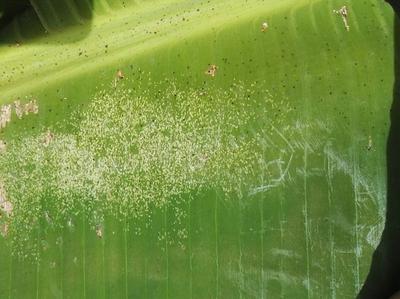Banana Lace Wing Bug
Stephanitis typica
Insect
In a Nutshell
- Tiny, white chlorotic spots on upper leaf side.
- Dark extract on lower leaf side.
- Yellowing and withering of leaves.
- Adults are yellowish to whitish with translucent, fringed lace-like wings.
Can also be found in
Symptoms
The infestation is visible on the leaves, even from a distance. The adults and nymphs are located on the lower leaf side, where they live in colonies and feed on the leaves. Most commonly, the insects feed on the leaf sap around the middle vein. The feeding damage appears as tiny white, chlorotic spots on the upper leaf side. Dark insect secretions are left on the lower leaf surface. The colonized areas turn yellow to brown over time and dry out. Trees have a stunted growth and look sickly.
Recommendations

Organic Control
Predatory insect species such as Stethoconus praefectus may reduce the infestation if used in an integrated approach. An emulsion of neem oil and garlic (2%) can be used as foliar spray applications to control the infestation.

Chemical Control
Always consider an integrated approach with preventive measures together with biological treatments. The use of insecticides is the most common way of fighting this disease. Products containing dimethoate can be used as foliar spray applications. These should be applied so the lower surface of the leaves is covered with product.
What caused it?
The adults are yellow to whitish and about 4 mm in size with translucent, fringed lace-like wings. The female beetle lays about 30 eggs on the lower leaf side. After about 12 days the yellow nymphs hatch. This development stage lasts for about 13 days. Currently, there is no detailed information available regarding yield losses due to banana lace wing bug infestation. Until now, there are no reports about serious damage on banana plants caused by the pest.
Preventive Measures
- Plant tolerant or resistant varieties if available.
- Check your plants or fields regularly for any sign of the pest.
- Handpick and destroy the first infested outer whorl of leaves in the field to curb the progression of the infestation.



